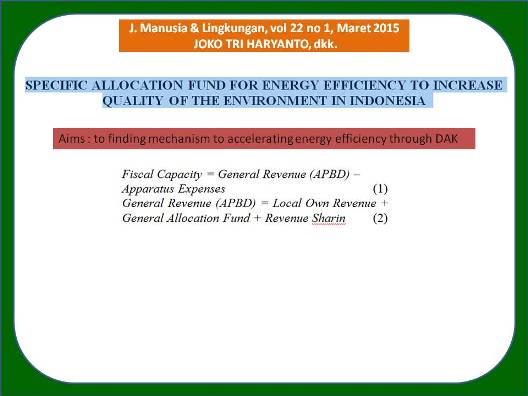
SPECIFIC ALLOCATION FUND FOR ENERGY EFFICIENCY TO INCREASE QUALITY OF THE ENVIRONMENT IN INDONESIA (Mekanisme Dana Alokasi Khusus Efisiensi Energi dalam Mendukung Perbaikan Lingkungan di Indonesia)
Joko Tri Haryanto(1*)
(1) Centre for Climate Change Financing and Multilateral Policy, Fiscal Policy Office-Ministry of Finance of Indonesia, Jl. Dr Wahidin Raya No 1, Jakarta Pusat.
(*) Corresponding Author
Abstract
ABSTRACT
Related to the climate change and economic development of environmentally friendly (green economy) issues, the President has committed to reducing emissions of greenhouse gases (GHG) by 26% on their own sources (BAU), and up to 41% with international support in 2020 through Presidential Decree No. 61 in 2011 about the National Action Plan for Greenhouse Gas Emission Reduction (RAN-GRK). In addition to regulating the sectors that are considered to be the largest contributor to GHG emissions, the regulation also establishes funding sources RAN-GRK either through the APBN, APBD, as well as a variety of other sources constituted under the legislation. The main research question are; Is specific allocation fund (DAK) can be used to fund energy efficiency?; if so, what procedure should be done? and how monitoring and evaluating of the energy efficiency of the use of DAK ? To answer those questions, researcher using qualitative library research, cross sectional collection of data for intensive analysis, interviews to some leading experts in the field and a number of Focused Group Discussions were also conducted to construct the policy analysis. Based on the analysis of the mechanism of transfer to the regions in Indonesia, it is possible to enlarge of DAK field for energy efficiency by asking Line Minister to proposed mechanism and send to the Ministry of Finance. This can be addressed to support the achievement of environmental friendly activities and reduce the burden of state budget subsidies. Some of things that must be done is to propose the allocation of DAK EE into government programs and to develop a variety of specificized and technical indicators related.
ABSTRAK
Terkait dengan komitmen dalam mengatasi dampak perubahan iklim serta isu pengembangan ekonomi rendah karbon, Pemerintah telah mengesahkan Peraturan Presiden (Perpres) Nomor 61 Tahun 2011 tentang rencana Aksi Nasional Penurunan Emisi Gas Rumah Kaca Nasional (RAN-GRK) tahun 2020 sebesar 26% dengan usaha sendiri dan 41% dengan bantuan pendanaan asing. Dalam Perpres tersebut telah diatur sektor-sektor apa saja yang dianggap menjadi sumber emiten terbesar termasuk sektor energi, sekaligus adanya kewajiban pendanaan APBN/APBD dalam mengatasinya. Di sisi lain, kegiatan efisiensi energi tercatat sebagai salah satu aksi penurunan emisi GRK yang cukup signifikan dalam sektor energi baik untuk bangunan maupun mesin. Sayangnya kegiatan tersebut membutuhkan investasi yang cukup besar. Akibatnya kegiatan efisiensi energy menjadi tidak menarik. Di sinilah peran pendanaan APBN/ APBD menjadi sangat krusial. Terkait dengan pengaturan pengalokasian pendanaan APBN/APBD inilah peran Kemenkeu menjadi sangat vital, khususnya dalam mekanisme pengalokasian Dana Alokasi Khusus (DAK) yang menjadi kewenangannya. Dari hasil analisis, mekanisme alokasi DAK ternyata memungkinkan untuk ditujukan bagi pendanaan kegiatan efisiensi energi. Namun demikian, mekanisme yang harus dijalankan lebih difokuskan kepada inisiatif Kementerian/Lembaga (K/L) yang berwenang dalam pengusulan alokasi DAK tersebut.
Keywords
Full Text:
artikel lengkap (PDF)References
Anonymous, 2012. Peer Review on Low Carbon Energy Policies in Thailand Final Report, the APEC Energy Working Group. Bangkok.
Blumstein, C. Kreig, B. Schipper, L and York, C., 1980. Overcoming Social and Institutional Barriers to Energy Efficiency. Energy, 5(4):355–371.
Golove, W.H., and Eto, J.H., 1996. Market Barriers to Energy Efficiency: A Critical Reappraisal of the Rationale for Public Policies to Promote Energy Efficiency. LBNL, Berkeley. Pp 66.
Grüning, C., Menzel, C., Panofen, T., and Shuford, L.S., 2012. Case Study: The Thai Energy Efficiency Revolving Fund. Frankfurt School of Finance & Management gGmbH. Frankurt.
Hinge, A. Bertoldi, P., and Waide, P., 2004. Comparing Commercial Building Energy Use Around the World; The 2004 ACEEE Summer Study on Energy Efficiency in Buildings
Jaffe, A.B., and Stavins, R.N., 1994. Energy-Efficiency Investments and Public Policy. The Energy Journal, 15(2):43-65.
Kirsch, I., 1993. Adult Literacy in America: A First Look at the Results of the National Adult Literacy Survey. Website : http://literacy. kent.edu/Oasis/Pubs/nalsrev.htm.
Lovins, A., 1976. Energy Strategy: The Road Not Taken? Rocky Mountain Institute. Website : www.rmi.org.
Robinson, J.B., 1991. The Proof of the Pudding: Making Energy Efficiency Work. Energy Policy, September, pp 631-645.
Stern, P.C., 1986. Blind Spots in Policy Analysis: What Economics Doesn't Say about Energy Use. Journal of Policy Analysis and Management, 5(2):200-227.
Sanstad, A.H., and Howarth, R.B., 1994. Normal Markets, Market Imperfections, and Energy Efficiency. Energy Policy, 22(10):811-818.
Setyawan, D., 2013. Formulating Revolving Fund Scheme to Support Energy Efficiency Project in Indonesia, Energy Procedia Journal, 47:37-46.
Suminto, 2003. Beberapa Catatan Tiga Tahun Desentralisasi Fiskal. Majalah Anggaran, (edisi khusus), Jakarta.
Sutabur, T., 2012. Finance Energy Efficiency Projects through Financial Institutions: Energy Efficiency Revolving Fund. Department of Alternative Energy Development and Efficiency. Ministry of Energy. Thailand, Bangkok.
Sutherland, R.J., 1994. Energy Efficiency or The Efficient Use of Energy Resources?. Energy Sources, 16:257-268.
Article Metrics
Refbacks
- There are currently no refbacks.
Copyright (c) 2017 Jurnal Manusia dan Lingkungan







